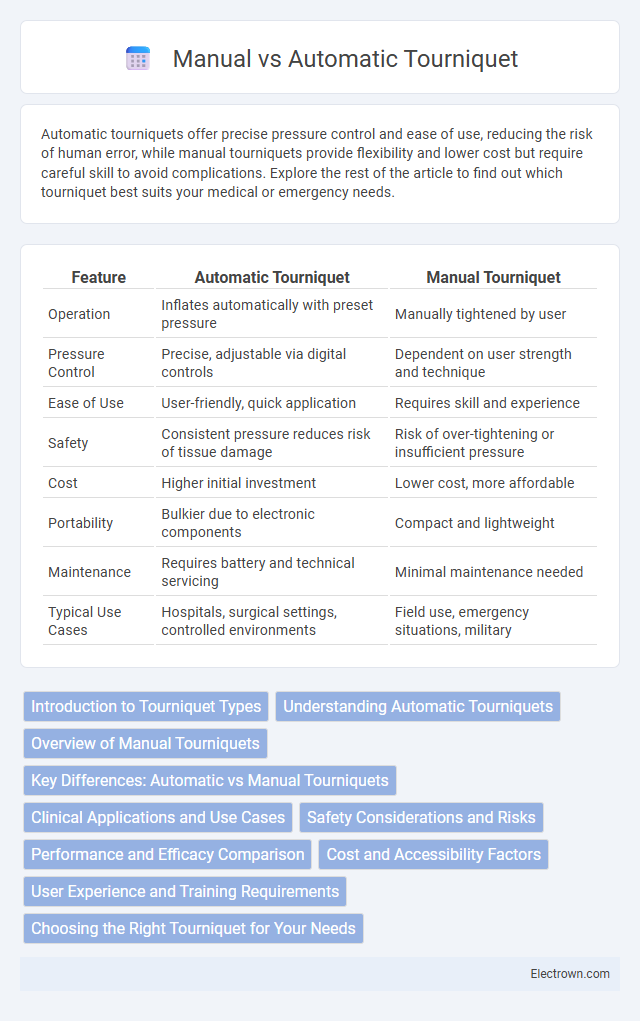Automatic tourniquets offer precise pressure control and ease of use, reducing the risk of human error, while manual tourniquets provide flexibility and lower cost but require careful skill to avoid complications. Explore the rest of the article to find out which tourniquet best suits your medical or emergency needs.
Table of Comparison
| Feature | Automatic Tourniquet | Manual Tourniquet |
|---|---|---|
| Operation | Inflates automatically with preset pressure | Manually tightened by user |
| Pressure Control | Precise, adjustable via digital controls | Dependent on user strength and technique |
| Ease of Use | User-friendly, quick application | Requires skill and experience |
| Safety | Consistent pressure reduces risk of tissue damage | Risk of over-tightening or insufficient pressure |
| Cost | Higher initial investment | Lower cost, more affordable |
| Portability | Bulkier due to electronic components | Compact and lightweight |
| Maintenance | Requires battery and technical servicing | Minimal maintenance needed |
| Typical Use Cases | Hospitals, surgical settings, controlled environments | Field use, emergency situations, military |
Introduction to Tourniquet Types
Automatic tourniquets utilize advanced pneumatic or mechanical systems to regulate pressure precisely, ensuring consistent occlusion with minimal user input. Manual tourniquets require physical tightening by hand, often using straps or windlasses, which provides tactile control but may vary in applied pressure. Selecting between automatic and manual types depends on clinical scenarios, ease of use, and the need for precise pressure monitoring to prevent complications.
Understanding Automatic Tourniquets
Automatic tourniquets use advanced pneumatic technology to provide precise, adjustable pressure, ensuring optimal limb occlusion during surgical procedures. These devices enhance safety by minimizing the risk of excessive pressure, reducing tissue damage compared to manual tourniquets that rely on manual tightening and subjective pressure control. Integration of digital controls in automatic tourniquets allows real-time monitoring of pressure and time, improving overall surgical outcomes and patient comfort.
Overview of Manual Tourniquets
Manual tourniquets are simple devices typically made from elastic bands, straps, or belts designed to constrict blood flow during emergencies or surgical procedures. They require physical adjustment by hand to tighten and secure around a limb, allowing precise control over pressure application. Manual tourniquets are commonly used in prehospital care and scenarios where portability and quick deployment are essential.
Key Differences: Automatic vs Manual Tourniquets
Automatic tourniquets use sensors and electronic controls to maintain consistent pressure, reducing the risk of excessive force and improving patient safety. Manual tourniquets rely on the operator's skill to adjust tension, which can lead to variability in pressure and potential for human error. The key differences include precision in pressure regulation, ease of use, and enhanced safety features found in automatic devices versus the simplicity and lower cost of manual models.
Clinical Applications and Use Cases
Automatic tourniquets provide precise pressure control and consistent application, making them ideal for complex surgical procedures and trauma care where rapid response is critical. Manual tourniquets are favored in emergency field settings and routine medical exams due to their portability, ease of use, and cost-effectiveness. Your choice between automatic and manual devices should align with specific clinical applications, procedural duration, and the need for pressure accuracy.
Safety Considerations and Risks
Automatic tourniquets offer precise pressure control, reducing the risk of nerve damage and tissue ischemia compared to manual tourniquets, which rely heavily on user skill and consistent monitoring. Manual tourniquets carry a higher chance of improper application, potentially causing excessive pressure or inadequate occlusion, leading to complications such as nerve injury or prolonged bleeding. Safety protocols emphasize continuous assessment of limb perfusion and timely release of both tourniquet types to minimize tissue damage and postoperative complications.
Performance and Efficacy Comparison
Automatic tourniquets provide consistent pressure regulation, reducing the risk of excessive force and tissue damage compared to manual tourniquets, which rely heavily on user skill and experience. Studies indicate that automatic devices achieve faster application times and maintain stable occlusion levels, enhancing overall hemostatic control during procedures. Your choice influences patient safety and procedure efficiency, with automatic tourniquets demonstrating superior performance and efficacy in controlled clinical settings.
Cost and Accessibility Factors
Automatic tourniquets often come with higher upfront costs due to advanced technology, making them less accessible for low-budget clinics or emergency situations in remote areas. Manual tourniquets, being simpler and cheaper, provide a cost-effective option widely accessible to healthcare providers worldwide. Your choice between automatic and manual tourniquets may depend on budget constraints and the availability of trained personnel to operate the device effectively.
User Experience and Training Requirements
Automatic tourniquets streamline user experience by offering consistent pressure application, reducing the risk of human error and enhancing safety during medical procedures. Manual tourniquets demand extensive training to ensure proper technique and pressure control, posing a higher risk for user variability and potential complications. Your choice between automatic and manual tourniquets should consider the balance between ease of use and the level of training available for optimal patient outcomes.
Choosing the Right Tourniquet for Your Needs
Selecting the right tourniquet depends on the situation, with automatic tourniquets offering rapid, consistent pressure ideal for emergency settings and manual tourniquets providing adjustable control valued in surgical or training scenarios. Factors such as application speed, pressure accuracy, ease of use, and portability influence the choice between automatic models like pneumatic or windlass systems and manual designs like elastic or ratcheting devices. Understanding patient condition, required pressure, and environment ensures optimal hemorrhage control and improved patient outcomes.
Automatic vs Manual Tourniquet Infographic

 electrown.com
electrown.com